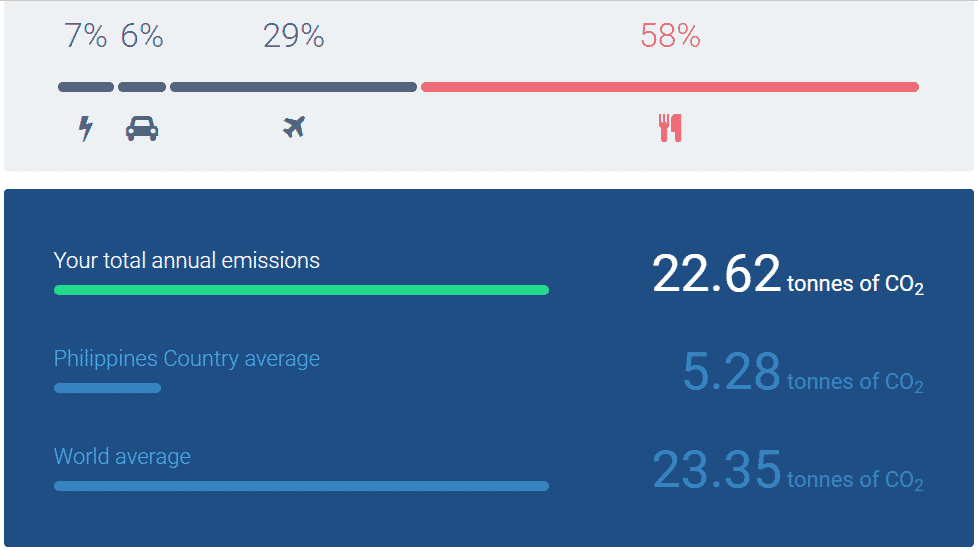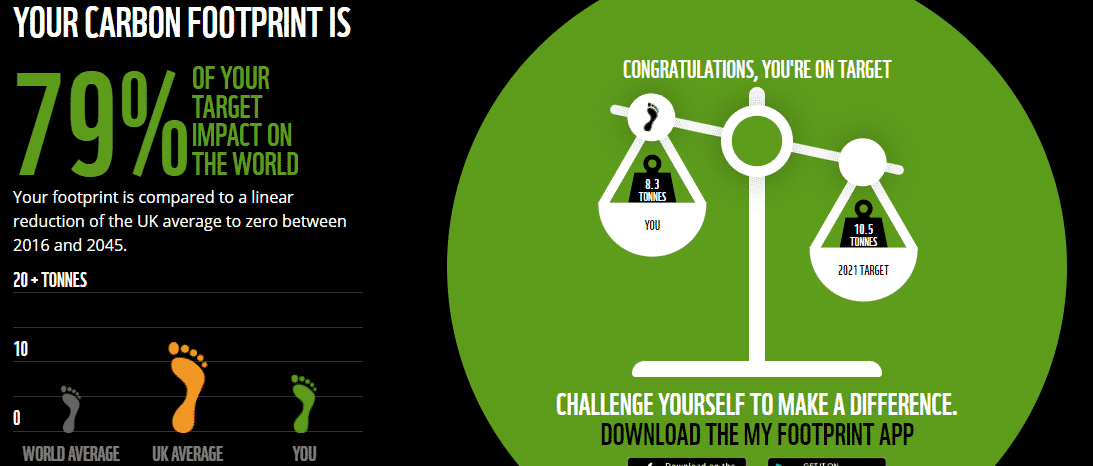Are you wondering how much carbon dioxide you release into the air? Then you may want to know what is your carbon footprint.
Every time you do something that burns fossil fuels, you emit carbon into the atmosphere. If you’re driving a car, flying in a plane, eating something, or only watching TV, you’re emitting carbon.
Your home or the building you’re living in also factors into your personal emissions.
Some people emit more carbon dioxide than others. But your individual carbon footprint is a part of the total emissions released into the air. It all adds up.
So, it’s crucial that we know our individual carbon footprints and how we can reduce them. It will help the world’s quest to reverse the disastrous climate change effects.
This guide will help you know how much CO2 you’re emitting and what are the ways you can do to reduce it.
What’s Your Individual Carbon Footprint?
According to WHO, a carbon footprint is a measure of the impact your activities have on the amount of carbon dioxide released into the air.
These CO2 emissions are through the burning of fossil fuels and are expressed in tons. They also include emissions including other GHGs like methane and chlorofluorocarbons (CFCs).
But since CO2 is the major GHG that causes warming, it’s used most often in getting carbon footprint.
Globally, the average individual generates about 4 tons of CO2 each year. But each person in the U.S. produces about 16 tons of carbon in a year. In other countries, averages vary a lot with higher emissions found in developed nations.
Yet, the average global CO2 footprint a year has to drop to 2 tons by 2050 for the world to have the best chance of avoiding a critical 1.5℃ rise in temperature.
And cutting the individual carbon footprint to only 2 tons won’t happen overnight.
But it’s possible through small changes in daily actions such as eating less meat or line drying clothes.
-
Transportation and household energy use are the biggest parts of an individual’s carbon footprint.
For example in the U.S., about 40% of total emissions during the 1st decade of the 21st century were from those sources. They’re the primary carbon footprint of individuals over which they have direct control over it.
Secondary carbon emissions usually refer to the consumption of goods and services. Food production includes this, for instance.
Take for example the case of producing a bottle of water a person drinks. Its carbon footprint includes the emissions released during its manufacture. Add to this the emissions of shipping the product.
Likewise, foods shipped over long distances and those with more meat need a higher amount of energy to produce.
Hence, your own carbon footprint is a vital means to understand the impact of your actions on global warming. This is why it’s important to measure and keep track of your emissions if you want to help fight the climate crisis, at least on an individual level.
So, how do you know what’s your personal carbon footprint?
How to Measure Your Own Carbon Footprint
You can figure out how much your actions generate GHG by using a carbon footprint calculator.
There are plenty of various tools created for calculating carbon footprints for individuals. But they’re different from the ones used to calculate carbon emissions by businesses and other entities.
Emissions by companies are often measured using a more complicated, scientific approach. And most businesses need to follow certain regulations to offset their emissions.
Calculating the offset they need to reduce or avoid footprint usually involves buying carbon credits. They’re permits given to companies in relation to their emissions.
Carbon offset credits have been on the rise due to the urgent need to mitigate climate issues. Large businesses are using them to address their big carbon footprint.
Here’s our complete guide to understanding how the emissions offset scheme with carbon credits works.
-
A carbon footprint calculator for an individual considers the GHG you emit at home. It may also include the emissions you contributed when traveling.
This calculator allows you to compare your footprint with national and global averages. There are a couple of online CO2 footprint calculators you can use.
In the U.S., there’s the Environmental Protection Agency. For those in the UK, as well as for others from different nations, the WWF calculator is helpful. While the one from the United Nations is useful for people from all parts of the globe to use.
Not all online calculators are the same. But they’re asking for similar pieces of information from you to calculate your individual carbon footprint.
Example questions are:
- What is the size of your household,
- What your diet is,
- How often you dine out,
- How much do you drive using different transport vehicles,
- The frequency of your flight,
- What kind of energy you’re using at home,
- How much energy you’re consuming,
- Your recycling practices, etc.
In essence, they’re asking for details about your household, travel, and lifestyle. The images below show some samples of the personal carbon footprint results generated by the calculators.


-
The result you’ll get after providing the information may not be 100% accurate.
That’s understandable though as there are a lot of factors affecting the standard values the calculators are using. Plus, the numbers you may provide are only estimations and not the exact amount you actually used.
Take the emissions of eating meat, for instance. While eating meat emits higher carbon than vegetables, it still depends on where you buy the meat. If you buy it locally, then it has fewer emissions.
Not to mention that the estimations you give and calculated don’t account for goods and services that come with them. So, what matters is to get your average individual carbon footprint.
Using those online calculators is a good way to start understanding your personal emissions. And from there, you can work on how to improve and reduce your carbon footprint.
How to Reduce Carbon Footprint?
As we can suggest from the situation above, it’s not easy to get your exact emissions. But you need to make estimations to have something to base your reduction efforts on.
Your car may pollute less than the average value used. Or perhaps the meat you buy is less polluting as it’s sourced from your locality. Yet, the fact remains that they’re major emission sources.
Hence, it’s still possible to reduce your footprint in a more accurate way by using numbers that reflect your local reality.
Organizations tackling climate issues recommend ways on how people can cut their footprint.
The WHO, in particular, suggests some areas where you can reduce your individual carbon footprint. They tell on what behaviors are sustainable in cutting down emissions. Here are some examples you may consider.
Areas for Reducing Carbon Footprint
Transportation: Suggested Actions/Behaviors
- Avoid polluting car journeys – each liter of fuel burnt emits over 2.5 kg of CO2
- Favor walking, cycling or using public transport, especially trains
- If you are driving, share the ride with others and don’t speed as it uses more fuel and thus releases more carbon
- Avoid flying – aviation is the world’s fastest-growing source of emissions
- If you fly, think about offsetting your emissions
- You can offset your flight footprint by paying extra for offset credits, or partaking in digital carbon exchanges
Energy Use: Suggested Actions/Behaviors
- Pay attention to the temperature of your house – a 1ºC less lowers your footprint (and your bill) by up to 10%
- Set your devices so that they’re turned on only when you’re home, and mind their settings to be in the right temperature level
- Use energy-efficient lights like LED and turn them off when not needed
- Unplug cellphone chargers even if not connected to phones as they still drain electricity
- Enhance home insulation to get rid of using more devices
- Opt for a greener electricity supplier (uses renewable energy) to help promote low carbon sources
Food: Suggested Actions/Behaviors
- Lessen your consumption of animal products
- Eat locally-produced foods – they generate less pollution
- Recycle or compost organic waste to avoid methane emissions by decaying this waste in landfills – in the EU, this kind of emission accounts for ~3% of GHG emissions.
Waste Management: Suggested Actions/Behaviors
- Reject what you don’t need and reduce what you need
- Reuse or repurpose wastes as many times as possible
- Avoid buying new bags to bring your shopping items home by bringing your own shopping bag
- Pick products with little or no packaging – it will cut down production emissions
Personal choices that can significantly help mitigate climate pollution such as:
- Eating a plant-based diet
- Avoiding air travel
- Living car-free
- Choosing to have smaller families
The image below illustrates some ways to cut down a personal CO2 footprint.
Why do Individual Efforts to Fight Climate Change Matter?
Many people want to know what they can do individually to help tackle climate issues. In such a case, they need to know how their actions can have the biggest possible impact.
Climate change is a problem for the entire planet. In essence, climate science tells us that having a good future on Earth depends on reducing the total carbon footprint by about 90% by 2050.
The best time to act would have been years ago. Yet the next best time is now. And the sooner we take action to cut footprint, the more options we have to win the fight.
Hence, the actions you make today to cut your personal carbon footprint will make a huge difference in the future. It will add up to other individuals’ efforts of reducing their own emissions.
You can also check out how you can use carbon credits to offset your emissions here.


